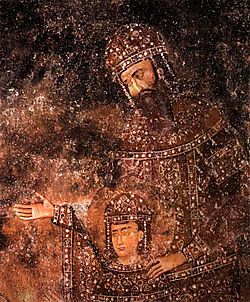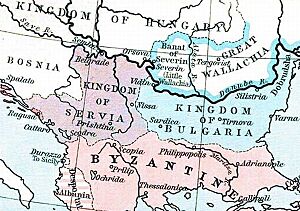Stefan Uroš I facts for kids
Quick facts for kids SaintStefan Uroš I Стефан Урош I |
|
|---|---|

A fresco at Sopoćani monastery, Serbia
|
|
| Ktetor | |
| Born | c. 1223 Raška |
| Died | 1 May 1277 (aged 55) Hum |
| Venerated in | Eastern Orthodox Church |
Stefan Uroš I (Serbian Cyrillic: Стефан Урош I; around 1223 – May 1, 1277) was a very important King of Serbia. People often called him Uroš the Great (Serbian: Урош Велики, romanized: Uroš Veliki). He ruled Serbia from 1243 to 1276. During his time, Serbia grew stronger and set the stage to become a big empire later on.
Contents
Early Life of King Uroš
Stefan Uroš was the youngest son of Stefan the First-Crowned, who was also a king. His mother was Anna Dandolo. Anna was the granddaughter of Enrico Dandolo, a famous leader from Venice. Uroš had two older half-brothers, Stefan Radoslav and Stefan Vladislav. Both of them were kings before him.
Some people think that Bulgaria had too much power in Serbia. This made many nobles unhappy. After the Bulgarian ruler died, these nobles chose Uroš to be their new king. From 1242 to 1243, there was a fight for the throne. In the end, his brother Vladislav had to give up the crown to Uroš. Uroš was kind to Vladislav. He let Vladislav rule the area of Zeta.
How King Uroš Ruled Serbia
Uroš became king when he was about 25 years old. He took the throne from his brother Vladislav. Even though he didn't have strong support from other royal families, he was a very active and determined ruler. Before he became king, Serbia had faced attacks from the Tatars. There were also many problems inside the country. Uroš quickly fixed these issues. He also improved Serbia's relationships with other countries.
The situation in Europe was good for Serbia. Uroš used this to his advantage. Under his rule, Serbia became much stronger and improved in many ways. Uroš decided that Serbia should expand south into Macedonia. He also planned to deal with Hungary in the Podunavlje region. He made Serbia ready for important political moves. This helped to make Serbia and the Serb people stronger in the Vardar valley and middle Podunavlje.
Uroš also made smart choices about trade. He often fought against the Republic of Ragusa. He wanted to stop Ragusa from controlling and profiting too much from Serbia's trade.
A key part of his rule was putting the state first. He made sure that churches, both Orthodox and Catholic, served the country's needs. He helped solve a big argument between two church leaders. This argument was about who had power in Serbia. Uroš made sure the leader from Bar won.
Uroš was the first Serbian king to really develop mining. Mines later became a main source of wealth for Serbia. Because of the mines, Serbia started making its own coins. These coins were similar to those used in Venice. He also supported writers and literature. He encouraged someone to write a new, detailed story about his grandfather, Nemanja. Uroš looked up to Nemanja a lot.
Uroš was married to Helen of Anjou. She was from a French royal family. He lived a simple life with his family. He was happy and content. Unlike the fancy Byzantine court, Uroš proudly showed off how modest his own court was. Everyone at his court was expected to work hard.
Serbia's Economy Grows
Under King Stefan Uroš I, Serbia became a powerful country in the Balkans. This was partly because of new mines. These mines were developed by skilled miners called "Sasi" (Saxons). They knew a lot about digging for ore. The Saxon settlements near the mines had special rights. They lived by their own laws. They could also practice Catholicism and build their own churches. Important mines were found at places like Novo Brdo, Brskovo, and Rudnik.
Trade also helped Serbia's economy grow. Serbia traded more with cities like Dubrovnik and Kotor on the coast. More silver from the mines and more trade meant Serbia could make more royal coins. These coins were based on the Venetian money.
Important Battles and Agreements
War with Ragusa
From 1252 to 1253, Uroš I fought a war with the Republic of Ragusa. Ragusa was a city-state next to Hum, which was ruled by Uroš's relative, Radoslav Andrijić. Radoslav promised to fight Ragusa as long as it was against Serbia. Ragusa then made an alliance with Bulgaria. Peace was finally made on May 22, 1254.
Later, in the late 1260s, another war started with Ragusa. The Serbian queen secretly supported Ragusa. A peace treaty was signed in 1268. This treaty said how much money Dubrovnik had to pay Serbia each year. This agreement lasted for about a hundred years.
War with Hungary
In 1268, the Serbian king attacked Hungarian lands south of the Danube river. This area is now western central Serbia. Even though Uroš had some early success, he was captured by the Hungarians. He had to pay to be set free. A peace treaty was then signed between Serbia and Hungary. As part of this peace, Stefan Uroš's son, Stefan Dragutin of Serbia, married Catherine. She was the daughter of the future Hungarian king, Stephen V of Hungary.
Conflict with His Son
Towards the end of his rule, Stefan Uroš managed to take more control over Hum. The local leaders there became less independent. In his efforts to make the country more centralized, the king seemed to upset his oldest son. He refused to give his son a special area to rule. The disagreement between father and son grew worse. The king even thought about making his younger son, Stefan Milutin, his heir instead.
Stefan Dragutin worried about his future and his life. So, in 1276, he finally demanded the throne. When Stefan Uroš said no, Dragutin rebelled. He got help from his Hungarian relatives. The allies defeated the Serbian king. Stefan Uroš had to give up his throne. He went to a monastery in Hum, where he died a year or two later. His body was later moved to his monastery, Sopoćani.
Buildings and Monasteries
Family Life
King Stefan Uroš I and his wife, Helen of Anjou, had at least three children:
- Stefan Dragutin, who became king after him.
- Stefan Milutin, who became king in 1282.
- Brnjača, a daughter.
|
Stefan Uroš I
Born: 1223 Died: 1 May 1277 |
||
| Regnal titles | ||
|---|---|---|
| Preceded by Stefan Vladislav |
King of Serbia 1243–1276 |
Succeeded by Stefan Dragutin |





